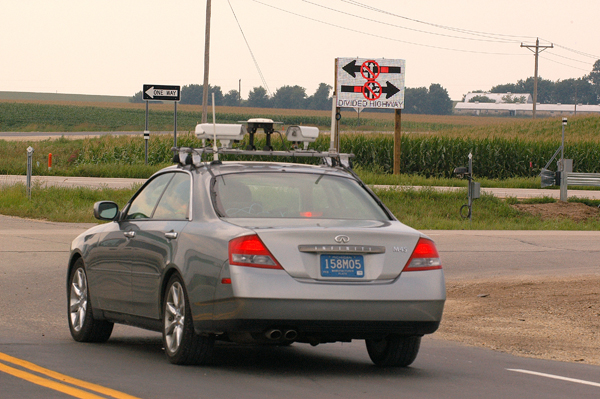By Craig Wilkins

A test car crammed with electronic sensors and computers approaches the warning sign at the intersection of Hwy 52 and Goodhue County Road 9 near Cannon Falls. Photo by David Gonzalez |
When researchers and traffic engineers talk about gap selection, they’re not talking about shopping for chinos at the mall.
What they are talking about is safety at “through-stop” divided highway intersections in the state’s more rural areas.
The gap in question is an open interval between approaching vehicles on the mainline when motorists on the cross street can enter the roadway safely.
The “through-stop” intersections pose the most risk because drivers must cross traffic moving in one direction, stop in the median and then blend into the traffic flowing in the other direction, said Michael Schweyen, traffic engineer with District 6/Rochester.
“Too often, drivers fail to judge the speed and distance of approaching vehicles accurately or they fail to see them at all,” Schweyen said. “Or they fail to yield properly or to stop after they enter the median.”
Serious crashes may result, often causing life-changing injuries or deaths.
Multi-agency approach
In order to reduce crash frequency and improve safety, Mn/DOT works with several other states, counties, the U. S. DOT and the University of Minnesota to test electronic signs and other methods to alert drivers when vehicles approach an intersection, said Ginny Crowson, Office of External Partnering director, the project’s former manager.
Crowson said that in 2006, for example, 56 of Minnesota’s 494 traffic deaths occurred at through-stop intersections.
The test installation is located where Goodhue County Road 9 crosses Hwy 52 seven miles south of Cannon Falls.
The signs are now in the pilot testing stage, Crowson said.
Initial testing includes employees from District 6 and Goodhue County driving the Safe Plow on Hwy 52 and area residents driving a sedan through the intersection. This allows researchers to analyze drivers’ response to the signs.
Both vehicles use on-board sensors and computers to collect and analyze data.
How the system will work
Crowson expects the system to be operational next year for long-term field testing.
When that happens, a driver heading east on the county road will encounter stop signs at Hwy 52.
The driver will then see the new electronic sign which will indicate if there are vehicles approaching on Hwy 52 and whether there is an adequate gap to cross.
“Future installations of this system at other intersections will depend upon the success of this test,” Schweyen said.
There are more than 3,900 through-stop intersections in Minnesota.
“This project represents research on crash-avoidance systems and reaching a national consensus for addressing rural intersection safety,” Crowson said.
“The project also supports the state’s Toward Zero Deaths campaign vision and goals,” she said. |



